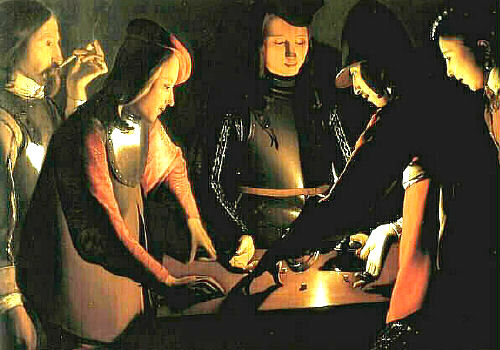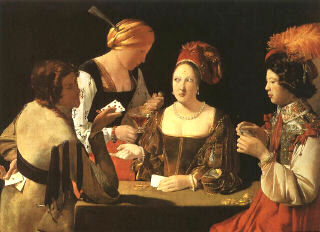Insights to Art
De La Tour's The Dice Players

Georges de La Tour, Dice Players - Preston Hall, Stockton, GB

Georges de La Tour, The Dice Players (early 1650s; 75cm x 99cm)
Forgotten and Rediscovered
Georges de La Tour (b. 1593, d. 1652), though famous in his time, was almost forgotten until the early 1900s. Soon after his death, his simple, balanced, uncluttered style became unfashionable and unheeded as the baroque came into vogue. Likewise this painting was forgotten until 1972 when it was discovered in Stockton-on-Tees, northern England. It is signed on the left "Georges de La Tour Invet et Pinx", though some experts doubt the authenticity of the signature and the painting itself. It has even been suggested that it may be the work of one of his sons, Etienne de La Tour, forging his father's signature to increase the value of the work. Nevertheless, the painting has many affinities with other works by Georges de La Tour, both stylistically and content-wise. The silent, fragile play on reds and browns found in The Dice Players is very similar to that of Peter's Denial (1650) and other works of the time, and the subject matter is close to that of The Card Players (around 1653), for example.

Georges de La Tour, The Card Players (Cheat with Ace) (c 1653)
The Life of de La Tour
De La Tour was born in the small town of Vic in Lorraine, eastern France, to humble parents - his father was a baker. Nothing is known of his formative years, though he may have had some artistic training in Nancy and it is thought he travelled to Italy at some time between 1610 and 1616 (and may have even been a pupil of Guido Reni). Like many artists of his time, he was especially influenced by the Italian artist Caravaggio, though this may have come indirectly from Dutch painters such as Hendrick Terbrugghen. His painting career was no doubt helped by his marriage to an aristocratic wife, and he obtained favours, commissions and recognition from the Dukes of Lorraine first and King Louis XIII later, bringing him fortune and fame (at least in his own time).
Lighting
Georges de La Tour was one of a number of 17th-century painters who cultivated a style of painting originally developed by Caravaggio and using strong and dramatic contrasts of light. Indeed de La Tour is often referred to as a "Carravaggist" or a "Caravaggesque" painter (others include Le Nain, Gentileschi and Zubaran). Caravaggio's famous style is based on dark surroundings with figures lit by a single emphatic light source, often a candle or a lamp. This shadowy ("tenebroso") style is particularly evident in works such as Caravaggio's Supper at Emmaus or his The Cardsharp. Almost all of de La Tour's works have strong single light sources, such as candles or torches, to give expressive effects, and this painting is no exception. The faces and outlines of the five figures in the painting are lit by a single candle burning brightly behind the arm of one of the soldiers. The armour of the soldier on the far side of the table reflects the glare of the flame, and the face in profile of the young spectator on the right is particularly light. On the other hand, the more elderly soldier smoking a pipe on the left is farthest away from the candle and in a fainter light. Unlike Caravaggio, however, de La Tour generally uses extremely warm colours, in particular a vast range of intense reds.
Attention to Detail
While Caravaggio influenced de La Tour in terms of lighting and composition, it was the Utrecht "tenebroso" masters, such as Terbrugghen and van Honthorst, working in Italy, who no doubt induced de La Tour to pay such exquisite attention to detail. The Dice Players is noteworthy for exquisitely rendered armour and helmets of the soldiers, their hair and hands, and the cap and earring of the young spectator on the right.
Balance and Shape
Georges de La Tour is also admired for his skilful pictorial compositions, and once again this work is no exception. The Dice Players is a particularly balanced, uncluttered, precise composition, with one face-on central figure and two figures in profile on either side. A strong diagonal line created by the line of sight of the young spectator and the front soldier's arm leads straight into the heart of the picture, the dice cast on a brightly-lit table. A three-dimensional impression is enhanced by the "circle" of figures and the angle of perspective for the table. De La Tour's tendency to use simplified shapes and volumes is evident in the faces, headwear and armour. For some art commentators, he is almost a precursor of Cubism.
Approaching the Subject
Many early 17th-century genre works by the Caravaggesque painters are ambiguous in their subject matter. In The Dice Players, it is unclear whether the spectator on the right, with a padded, jewelled hat and a pearl earring, is male or female. Likewise, the young soldiers appear extremely clean-shaven, finely and neatly clothed, and almost affected in their poses. Many of de La Tour's men have been criticised for seeming rather effeminate, and the young soldiers in this painting provide one of the best examples of such a trait. The meaning or moral of the picture would seem to hinge on the naive young spectator about to be drawn into a world of risks, about to be robbed of money and also of innocence. The painting has been described as a "metaphor of the lost illusions of youth".
© Nigel J. Ross, 2003
Home |
Publications |
Dictionaries |
English Lang. |
Art Insights |
Travel |
Links | ||||||